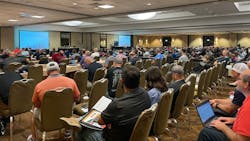Planning a new fire station? Debating whether to renovate or build new? Will a shared facility save money? These questions are the start of a complicated journey to a station that serves the needs of a community and of a department. It’s complicated—and daunting—whether it’s a department’s first station or its latest addition. For example, the increased focus on firefighter physical and mental health has brought significant changes to station designs. Other issues, such as heightened security and evolving electric technology (apparatus, drones and robots), require research into the future needs of a station. All the while, zoning, codes and the local community await the new station plan.
The 2023 Station Design Conference (May 22–25, 2023, Hilton at the Ball Park, St. Louis) is a unique resource for station design project management. This year’s conference presents the most recent trends and innovations in fire, law enforcement, training and public safety facilities. Presenters include fire department chiefs and project managers, architectural firms and consultants who specialize in these buildings.
Since 2014, the goal of the conference has been to be a win-win for every participant. In a three-fold approach, fire department and law enforcement attendees learn about designing and building new facilities, including from peers; conference speakers’ targeted presentations pique the interest of project managers; and attendees and speakers are afforded the opportunity to meet with exhibitors that specialize in public safety services and products to learn about their experience and hear their insights.
By popular demand
For the past eight years, most of the people who attended the conference were new to designing a station. Based on that fact, the 2023 program includes an introduction to/the basics of planning, design and construction, not only for first-time attendees but for returnees, too, to ensure that their project is on track.
The 2023 conference will comprise four tracks, so attendees can tailor the event to meet their needs. Track One and Track Two will target fire facilities; Track Three is law enforcement; and Track Four includes programs on shared facilities, training facilities and emergency operations centers (EOCs).
What’s new for 2023? Based on survey responses from last year’s attendees, the range of topics was expanded to include NFPA standards for fire station designs; details on how to make a station more functional; working with planning commissions and zoning appeals; net-zero energy design; and designing fire stations for functionality, ease of maintenance and low operating costs. Popular project case studies that provide valuable lessons learned will be increased for 2023.
From soup to nuts
Registration for the conference includes breakfast, lunch and break refreshments and entry to the Welcome Reception on the evening of Tuesday, May 23. The latter promises to provide valuable networking with peers, speakers and exhibitors.
The general session, which begins earlier in the day on Tuesday, will deliver a 30,000-foot view of building a fire station, training center or public safety facility, from start to finish. The fast-paced presentation by Ken Newell of Stewart-Cooper-Newell Architects can serve as a roadmap for how one selects other presentations to attend.
Track One will focus on the early stages of planning and design. Presentations include an explanation of why creating a “program” is important; 25 characteristics to consider before purchasing land or accepting “free” land; and financial strategies and resources for funding a project.
The hands-on “4-1-1 on Materials” program will provide the opportunity to touch, feel and learn about building materials and to dig into costs of installations.
In Track Two, fire chiefs team with their architects to explain challenges that they encountered in recent projects. Solutions to some of these challenges included the benefits of prototype fire stations and the use of the latest technology for apparatus bays and for laundry and decontamination.
To serve those who must balance access for citizens of the community to a police station with heightened protection for sworn personnel and civilian employees, Track Three’s presentations will examine new technology for interview rooms, security systems and reinforced exterior protection, among other topics.
The benefits of co-locating fire and law enforcement in one facility is among several topics in Track Four. Of course, there are the financial advantages of one construction site for two agencies. Sharing fitness rooms, training space and meeting rooms also can figure into the equation.
Specialty areas are among other Track Four presentations. For example, the popular “How to Read a Blueprint” program can help to build confidence in project management. Attendees also will be afforded the opportunity to learn how 24/7/365 facilities can achieve not only net-zero energy but net-positive performance.
Increase your confidence
More than 60 programs and speakers make the 2023 Station Design Conference an incomparable resource for a department/municipality that requires facility expansion and/or upgrade. Start your next fire station, training center or shared facility by tapping experienced resources that you can trust. More information is available at fhstationdesign.com.
Direct Access to Architects
On Monday, May 22, the “1-on-One” pre-conference program will provide an invaluable opportunity for attendees to have architects who specialize in fire and law enforcement station design review a project no matter where in the process the project stands.
This pre-conference program requires a separate registration and fee.
About the Author
Firehouse Staff
Content written and created by Firehouse Magazine editors.
